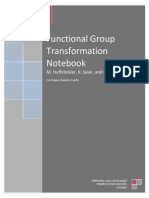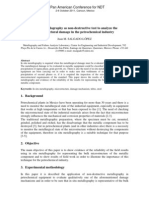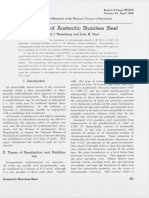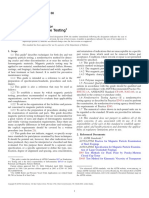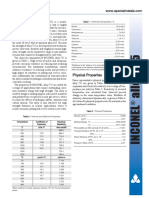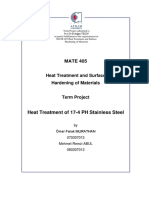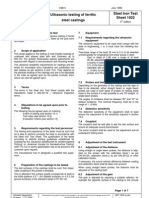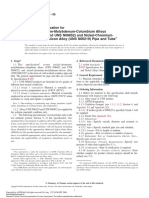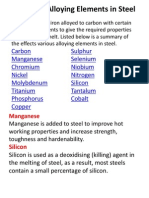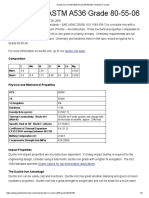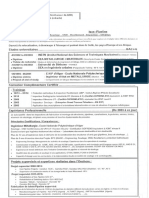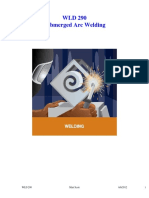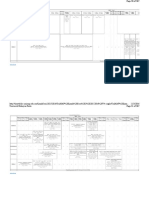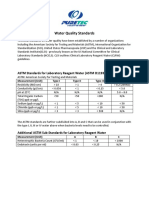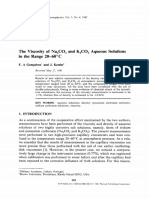254-Smo
254-Smo
Uploaded by
Danem HalasCopyright:
Available Formats
254-Smo
254-Smo
Uploaded by
Danem HalasOriginal Title
Copyright
Available Formats
Share this document
Did you find this document useful?
Is this content inappropriate?
Copyright:
Available Formats
254-Smo
254-Smo
Uploaded by
Danem HalasCopyright:
Available Formats
High Performance
Austenitic Stainless Steel
Steel grades
Outokumpu
904L
254 SMO
4565
EN
ASTM
1.4539
1.4547
1.4565
N08904
S31254
S34565
Characteristic properties
General characteristics
High performance austenitic stainless steels differ substantially from more conventional grades with regard to resistance
to corrosion and, in some cases, also mechanical and physical
properties. This is mainly due to the high contents of chromium, nickel, molybdenum and nitrogen. High performance
austentic stainless steels have good weldability and excellent
formability.
Outokumpu manufactures a number of steels of this type:
904L, 254 SMO and 4565. Grade 4529 can also be delivered if specified. The properties of 4529 are in general terms
very similar to those of 254 SMO.
Very good resistance to uniform corrosion
Good to exceptionally good resistance to pitting and
crevice corrosion
Very good resistance to various types of stress
corrosion cracking
Good ductility
Good weldability
Applications
Process equipment in chemical industry
Bleaching equipment in the pulp and paper industry
Flue gas cleaning
Desalination
Seawater handling
Hydrometallurgy
Food and beverage
Pharmaceuticals
Heat exchangers
Chemical composition
The typical chemical composition of Outokumpu grades are
shown in table 1. The chemical composition of a specific
steel grade may vary slightly between different national standards. The required standard will be fully met as specified on
the order.
Chemical composition
Duplex Austenitic
Outokumpu
steel name
Table 1
International
steel No
Chemical composition, %
typical values
National steel designations,
superseded by EN
EN
ASTM
Cr
Ni
Mo Others
BS
DIN
NF
SS
4404
4439
904L
254 SMO
4529
4565
1.4404
1.4439
1.4539
1.4547
1.4529
1.4565
316L
S31726
N08904
S31254
N08926
S34565
0.02
0.02
0.01
0.01
0.01
0.02
0.14
0.20
0.20
0.45
17
18
20
20
20
24
10
13
25
18
25
17
2.1
4.1
4.3
6.1
6.5
4.5
1.5 Cu
Cu
Cu
5.5 Mn
316S11
904S13
1.4404
1.4439
1.4539
1.4529
1.4565
Z3 CND 17-11-07
Z3 CND 18-14-05 Az
Z2 NCDU 25-20
2348
2562
2378
2205
SAF 2507
1.4462 S32205*
1.4410 S32750
0.02 0.17 22
0.02 0.27 25
5.7
7.0
3.1
4.0
318S13 1.4462 Z3 CND 22-05 Az
Z3 CND 25-06 Az
* Also available as S31803
www.outokumpu.com
2377
2328
High Performance Austenitic Stainless Steel
Microstructure
Mechanical properties
The high performance austenitic stainless steels have a fully
austenitic microstructure in the quench annealed
condition. They can, however, contain traces of intermetallic phases (sigma phase) at the centre of the material.
Normally, this does not affect the corrosion resistance or
mechanical properties of the steel. Provided that the recommendations given for hot forming, welding and heat treatment are followed, such precipitates have negligible effect
on usability.
The strength and elongation of 904L are similar to those
for conventional austenitic stainless steels. The addition of
nitrogen in 254 SMO and 4565 gives higher proof strength
and tensile strength, see tables 2 and 3.
Despite the greater strength of these steels, the possibilities
for cold as well as hot forming are very good.
Mechanical properties at 20C
Table 2
Minimum values,
according to EN 10088
H
P (15mm)
MPa
MPa
MPa
%
220
260
520
35
220
260
530
35
240
270
530
35
260
300
600
50
155
Rp0.2
Rp1.0
Rm
A5
HB
MPa
MPa
MPa
%
300
340
650
40
300
340
650
35
320
350
650
35
340
380
680
50
160
Rp0.2
Rp1.0
Rm
A5
HB
MPa
MPa
MPa
%
420
460
800
30
420
460
800
30
420
460
800
30
440
480
825
55
200
904L
Proof strength
Proof strength
Tensile strength
Elongation
Hardness
Rp0.2
Rp1.0
Rm
A5
HB
254 SMO
Proof strength
Proof strength
Tensile strength
Elongation
Hardness
4565
Proof strength
Proof strength
Tensile strength
Elongation
Hardness
Typical values
P = hot rolled plate. H = hot rolled strip. C = cold rolled coil and strip.
Tensile properties at elevated temperatures, minimum values according to EN, MPa
Table 3
Rp0.2
904L
Rp1.0
Rm
254 SMO
Rp0.2
Rp1.0
Rm
Rp0.2
4565
Rp1.0
100C
200C
300C
400C
205
175
145
125
235
205
175
155
500
460
440
230
190
170
160
615
560
525
510
350
270
240
210
400
310
270
240
270
225
200
190
Rm
750
640
640
610
Physical Properties
In table 4 typical values of some physical properties are given for 904L, 254 SMO and the grade 4565.
Typical values according to EN 10088
Table 4
Density
Modulus of elasticity
Linear expansion at (20 100)C
Thermal conductivity
Thermal capacity
Electric resistivity
g/cm
GPa
x10-6/C
W/mC
J/kgC
m
3
904L
254 SMO
4565
8.0
195
15.8
12
450
1.0
8.0
195
16.5
14
500
0.85
8.0
190
14.5
12
450
0.92
904L
40
4404
20
0
10
20 Steel
High Performance
Austenitic
Stainless
30
H2SO4 +2000 ppm Cl
Corrosion resistance
Uniform corrosion
The high content of alloying elements gives the steels 904L,
254 SMO and 4565 exceptionally good resistance to uniform corrosion.
904L was originally developed to withstand environments involving dilute sulphuric acid and it is one of the
few stainless steels that at temperatures of up to 35C provides full resistance in such environments within the entire
range of concentration, from 0 to 100%, fig 1. 904L also
offers good resistance to a number of other inorganic acids,
e.g., phosphoric acid, as well as most organic acids.
Acids and acid solutions containing halide ions can, however, be very aggressive and the corrosion resistance of 904L
may be insufficient. Examples of such acids are hydrochloric
acid, hydrofluoric acid, chloride contaminated sulphuric
acid, phosphoric acid produced according to the wet process
(WPA) at elevated temperatures, and also pickling acid based
on nitric acid and hydrofluoric acid mixtures. In these cases
254 SMO and 4565 are preferable and in certain cases they
can be an alternative to other considerably more expensive
Temperature, C
alloys, Figures 2-5 and tables 5 and 6.
100
80
Temperature, C
904L
100
Temperature, C
100
80
60
254 SMO
904L
40
4404
20
0
5
HCI %
Fig. 3. Isocorrosion curves, 0.1 mm/year, in pure
Temperature, C
100
hydrochloric acid.
Temperature, C
80
100
4565
60
60
80
4404
80
904L
4404
40
60
4565
40
60
254 SMO
20
400
10
20
30
40
50
60
70
80
90
904L
100
H2SO4 %
4404
20
40
0
254 SMO
10
20
30
40
50
4404
254 SMO 2
4
HF %
904L
20
0
254 SMO
4404
4404
60
70
80
90
100
20
0
4
HF %
H2SO4 %
Fig. 1. Isocorrosion curves, 0.1 mm/year, in pure sulphuric acid.
Fig. 4. Isocorrosion curves, 0.1 mm/year, in pure
hydrofluoric acid.
Temperature, C
100
Temperature, C
100
Temperature, C
80
100
80
Temperature, C
100
254 SMO
4565
60
60
80
80
40
60
904L
254 SMO
4404
20
0
40
904L
10
4565
40
60
4404
20
H2SO4 +2000 ppm Cl
4404
Fig. 2. Isocorrosion curves, 0.1 mm/year, in sulphuric
20
acid containing 2000 ppm chloride.
0
30
10
20
30
H2SO4 +2000 ppm Cl
20
40
0
5
4404
254 SMO
904L
10
15
20
25
30
35
254 SMO
H2SiF6 %
904L
20 Fig. 5. Isocorrosion curves, 0.1 mm/year, in pure
0
fluosilicic
5
10 acid. 15
20
25
30
35
H2SiF6 %
High Performance Austenitic Stainless Steel
Uniform corrosion in wet process
PRE values for different stainless steels
phosphoric acid at 60C
Steel grade
Steel grade
4404
904L
254 SMO
Corrosion rate, mm/year
>5
1.2
0.05
Composition: 54% P2O5, 0.06% HCl, 1.1% HF,
4.0% H2SO4, 0.27% Fe2O3, 0.17% Al2O3, 0.10% SiO2,
0.20% CaO and 0.70% MgO
Uniform corrosion in pickling acid at 25C
Steel grade
4404
904L
254 SMO
Table 6
Corrosion rate, mm/year
>5
0.51
0.31
Composition: 20% HNO3, 4% HF.
Better material may sometimes be needed for the
fractional distillation of tall oil than the 4404, or even the
more frequently used 4439. Table 7 presents the results of
exposing test coupons at a Swedish tall oil plant with the
object of determining suitable material for woven packings
of stainless steel.
In this particular case, packings produced from about
20,000 km of 0.16 mm diameter 254 SMO wire were used.
Corrosion rates in a fatty acid column for the
distillation of tall oil at 260C
Steel grade
4404
4439
904L
254 SMO
Table 8
Table 5
4404
4439
2205
904L
SAF 2507
254 SMO
4565
25
33
35
35
43
43
46
The PRE value can be used for rough comparisons of different materials. A much more reliable means, however, is to
rank the steel according to the critical pitting temperature of
the material (CPT).
There are several different methods available to measure
the CPT. Figure 6 shows the CPT, as measured in the Avesta
Cell (ASTM G 150), in a 1M NaCl solution (35,000 ppm
or mg/l chloride ions). The actual value of mill finish surface
may differ between product forms.
CPT, C
100
80
60
40
Table 7
Corrosion rate, mm/year
PRE
0.88
0.29
0.06
0.01
In hot concentrated caustic solutions the corrosion
resistance is mainly determined by the nickel content of the
material, and 904L in particular can be a good alternative to
more conventional stainless steels.
For more detailed information concerning the
corrosion resistance of the different steels in other
environments, see our Corrosion Handbook.
Pitting and Crevice corrosion
Resistance to pitting corrosion (and also crevice corrosion)
is determined mainly by the content of chromium, molybdenum and nitrogen in the material. This is often illustrated
using the pitting resistance equivalent (PRE) for the material, which can be calculated using the formula:
PRE = %Cr + 3.3 x %Mo + 16 x %N. PRE values are presented in table 8.
20
0
4404
4439
2205
904L
SAF
2507
254
SMO
4565
Fig. 6. Typical critical pitting corrosion temperatures
(CPT) in 1M NaCl measured according to ASTM
G150 using the Avesta Cell. Test Surfaces wet
ground to 320 mesh. CPT varies with product
form and surface finish.
Grade 4565 has such a good resistance to pitting that common test methods are not sufficiently aggressive to initiate
any corrosion. A better measure of resistance is given by evaluating the results of various crevice corrosion tests.
High Performance Austenitic Stainless Steel
In narrow crevices the passive film may more easily be
damaged and in unfavourable circumstances stainless steel
can be subjected to crevice corrosion. Examples of such narrow crevices may be under gaskets in flange fittings, under
seals in certain types of plate heat exchangers, or under hard
adherent deposits.
Crevice corrosion occurs in the same environments as pitting. Higher contents of chromium, molybdenum or nitrogen enhance the corrosion resistance of the steel, see
fig 7.
CCT, C
60
50
40
30
Guide to Material Selection
Fig 8 illustrates to which approximate temperatures stainless
steel can be used in oxygen saturated waters of varying chloride content. It should be underlined that the resistance of a
material is also influenced by factors other than temperature
and chloride content. Examples of such factors are weld
defects, presence of oxide from welding, contamination of
the steel surface by particles of non-alloyed or low-alloyed
steel, microbial activity, pH and chlorination of water.
A deeper and more severe crevice is formed between the
gasket and the plate in plate heat exchangers due to the
curved contact surface. Thereof the two boundary lines for
crevice corrosion on 254 SMO in fig. 8.
It should, however, be noted that the crevice geometry of
a flange joint is dependent on the pressure that is obtained
when tightening screws and bolts. The boundary line for
crevice corrosion under normal conditions can in practice
therefore be similar to that which applies to crevice corrosion for plate heat exchangers. Also threads contain equally
severe crevices, which should be considered when designing
joints in highly alloyed stainless steels.
Temperature, C
80
70 904L c
20
254 SMO c
60
904L p
10
50
254 SMO phe
40
0
4404
4439
904L
2205
SM
25
SA
0
25
6
45
Fig. 7. Typical critical crevice corrosion temperature (CCT) according to ASTM G48
Method F. Test surfaces dry ground to
120 mesh. CCT varies with product form
and surface finish.
254 SMO p
4404 c
30
4404 p
2205 c
2205 p
20
100
1000
Cl- ppm
10000
100000
p=pitting, full line c=crevice corrosion, broken line phe=plate heat exchanger
Fig. 8. Engineering diagram illustrating the risk of
pitting and crevice corrosion on high
performance stainless steel in water of different chloride content or temperature.
High Performance Austenitic Stainless Steel
Seawater
Stress corrosion cracking
Natural seawater contains living organisms, which very
quickly form a biofilm on stainless steel. This film increases
the corrosion potential of the steel and thus, also the risk of
pitting and crevice corrosion.
The activity of the biofilm is temperature related. The
different organisms are adapted to the natural water temperature of their habitat. Their activity therefore varies between
the different seas around the world. This means that in cold
seas the natural water is most aggressive at 25-30C while
the corresponding value in tropical seas is just above 30C.
The biological activity ceases at higher temperatures.
In many seawater systems the water is chlorinated with
either chlorine or hypochlorite solutions to reduce the risk
of fouling. Both chlorine and hypochlorite are strongly oxidising agents and they cause the corrosion potential of the
steel surface to exceed what is normal in non-chlorinated
seawater, which in turn means increased risk of corrosion. In
chlorinated seawater the aggressiveness increases as the temperature rises.
In crevice-free, welded constructions, 254 SMO may
normally be used in chlorinated seawater with a chlorine
content of up to 1 ppm at temperatures up to about 45C.
Higher alloyed materials, e.g. a Ni-base alloy, should be used
for flange joints, or the sealing surfaces should be overlay
welded, e.g., using an ISO NiCr25Mo16 type filler, if the
temperature exceeds 30C. Higher chlorine content can be
permitted if chlorination is intermittent.
The risk of crevice corrosion in non-chlorinated seawater
is considerably lower. 254 SMO has sucessfully been used
in some fifty installations for desalination of seawater according to reverse osmosis process.
Conventional stainless steels such as 4307 and 4404 are sensitive to stress corrosion cracking (SCC) under certain conditions, i.e. a special environment in combination with tensile
stress in the material and often also an elevated temperature.
Resistance to SCC increases with the increased content of
above all nickel and molybdenum. This implies that the high
performance austenitic steels 904L, 254 SMO and 4565
have very good resistance to SCC.
Different methods are used to rank stainless steel grades
with regard to their resistance to SCC. The results can vary
depending on the method and testing environment. The
resistance to stress corrosion cracking in a chloride solution
under evaporative conditions can be determined according to
the drop evaporation method. This means that a salt solution
is allowed to slowly drip onto a heated specimen, while it is
being subjected to tensile stress.
By this method the threshold value is determined for the
maximum relative stress not resulting in rupture after 500
hours testing. The threshold value is usually expressed as a
percentage of the proof strength of the steel at 200C. Fig. 9
shows the results of such a test.
High performance austenitic steels and duplex steels offer
considerably better resistance than 4404 to SCC, fig. 9.
Applied stress, in % of Rp0.2 at 200 C
120
100
80
60
40
20
<10
0
4404
2205
904L
SAF 2507 254 SMO
Fig. 9. Typical threshold stresses determined using
the drop evaporation test.
High Performance Austenitic Stainless Steel
The resistance to alkaline SCC is more dependent on the
nickel content of the material and also in this respect high
performance austenitic steels are superior to conventional
stainless steels. Nickel-based alloys are, however, to be preferred in the most demanding conditions.
Sulphide-induced stress corrosion cracking
Hydrogen sulphide can sometimes cause embrittlement of
ferritic steel and even of cold-worked duplex and austenitic
steels. The sensitivity to cracking increases when the environment contains both hydrogen sulphide and chlorides.
Such sour environments occur for example in the oil and
gas industry.
254 SMO is approved according to NACE MR0175
Standard Material Requirements - Metals for Sulfide Stress
Cracking and Stress Corrosion Cracking Resistance in Sour
Oilfield Environments
Intercrystalline corrosion
High performance austenitic steels have such a low carbon
content that the risk of conventional intercrystalline corrosion caused by chromium carbide precipitates in connection
with welding is negligible.
This means that welding can be performed without risk of
intercrystalline corrosion.
Erosion corrosion
Unlike copper alloys, stainless steel generally offers very
good resistance to impingement attack and there are no
motives for limiting the velocity of water, e.g. in piping
systems that convey seawater. Further, stainless steel is not
sensitive to seawater that has been contaminated by sulphur
compounds or ammonia.
In systems subjected to particles causing hard wear, e.g.,
sand or salt crystals, the higher surface hardness of duplex
steels can in some cases be an advantage.
Galvanic corrosion
The high performance austenitic steels 254 SMO and
4565 are not affected by galvanic corrosion if they are connected to titanium in systems used for conveying seawater.
However, the rate of corrosion for copper alloys is increased
if they come into contact with most stainless steels (or with
titanium). The intensity of corrosion is closely related to the
surface area ratio between the stainless steel and the copper
alloy, fig 10. The tests presented have been carried out with
254 SMO but the relation is the same for other high performance steels.
The galvanic effect is reduced somewhat if the seawater is
chlorinated.
Corrosion rate, mm/year
1.0
Muntz
metal
0.8
0.6
CuNi
70/30
0.4
Monel
Al-bronze
0.2
0.0
4
5
10
Area ratio 254 SMO/Metal
Fig. 10. Galvanic corrosion of copper alloys
in slow moving seawater at ambient
temperature.
High Performance Austenitic Stainless Steel
Fabrication
Hot forming
Suitable temperatures for hot forming are shown in Table 9.
Higher temperatures cause a deterioration in ductility and
an increase in the formation of oxides (scaling) Normally
hot working should be followed by solution annealing and
quenching but, for 904L, if the hot forming is discontinued at a temperature above 1100C and the material
is quenched directly thereafter the material may be used
without subsequent heat treatment. It is important that
the entire workpiece has been quenched from temperatures
above 1100C. In the case of partial heating or partial cooling below 1100C or if the cooling has been too slow, hot
working should always be followed by solution annealing
and quenching.
Both 254 SMO and 4565 should be quenched at a
temperature of at least 1150C after hot working to avoid
residual intermetallic phases. These phases can also rebuild
if the subsequent cooling process is too slow, resulting in
impaired corrosion resistance.
annealing of the material may sometimes be necessary, especially if the workpiece is welded.
The effect of work hardening, during and after coldforming, is illustrated in fig. 11 and 12.
Typical proof strength
Steel grade
Table 10
2 mm
Rp0.2,MPa
904L
254 SMO
4565
5 mm
Rp0.2,MPa
310 30
390 30
440 30
10 mm
Rp0.2,MPa
290 30
380 30
440 30
290 20
440 20
MPa/HB
A5
%
800
700
Rm
75
600
Rp0.2
Cold forming
500
All these steels have good ductility. Bending, pressing and
other forming operations can be performed without difficulty.
The high performance austenitic stainless steels, especially
254 SMO and 4565, cold-harden considerably faster than
conventional austenitic grades. This, together with the initial high strength, makes it necessary to apply high forming
forces. The spring back for grades 254 SMO and 4565 is
also greater than for conventional austenitic steels.
Typical proof strength values, R p0.2 , are given in
Table 10. About 90% of recorded values fall within
the limits shown.
Spinning of e.g. dished ends can be done but it is essen-
50
400
300
A5
HB
25
200
100
10
15
20
25
Cold deformation, %
Characteristic temperatures, C
Hot forming
Solution
annealing
Pressure vessel
approval
Fig. 11. 904L influence of cold deformation on
the mechanical properties.
Table 9
904L
254 SMO
4565
1200 - 950
1200 - 1000
1200 - 1000
1080 - 1160
1150 - 1200*
1120 - 1170
MPa
1400
A5
%
1200
Rm
(-60) - 400
(-60) - 400
(-196) - 400
* Quenching with water at a thickness above 2 mm,
below 2 mm an annealing temperature of 1120-1150C
and cooling with air/water can be used.
Rp1.0
1000
Rp0.2
800
60
600
tial that sufficiently high deformation forces are used to
ensure thorough plastic deformation of the material at the
very beginning of the operation. Otherwise there is a risk
that deformation only occurs on the surface and after a few
cycles of deformation it will be cold hardened to such a
degree that the tensile strength and rupture elongation of the
material are exceeded with subsequent cracking.
In complicated cold-forming operations, intermediate
40
400
A5
20
200
0
20
40
0
60
Cold deformation, %
Fig. 12. 254 SMO influence of cold deformation on the mechanical properties.
High Performance Austenitic Stainless Steel
Machining
Austenitic stainless steels work harden quickly and this,
together with their toughness, means that they are often
perceived as problematic from a machining perspective, e.g.
in operations such as turning, milling and drilling. This
applies to an even greater extent to most highly alloyed
steels and especially those that have a high nitrogen content,
i.e. 254 SMO and 4565.
However, with the right choice of tools, tool settings and
cutting speeds, these materials can be sucessfully machined.
For further information contact Outokumpu.
Welding
All these steels are well suited for welding and the methods
used for welding conventional austenitic steels can also be
used on 904L, 254 SMO and 4565. However, due to their
stable austenitic structure, they are somewhat more sensitive
to hot cracking in connection with welding and generally
welding should be performed using a low heat input.
On delivery, sheet, plate and other processed products
have a homogeneous austenitic structure with an even distribution of alloying elements in the material. Solidification
after partial remelting, e.g. by welding, causes redistribution
of certain elements such as molybdenum, chromium and
nickel. These variations, segregation, remain in the cast
structure of the weld and can impair the materials corrosion
resistance in certain environments.
Segregation tendency is less evident in 904L and this steel
is normally welded using a filler of the same composition as
the base material and it can even be welded without filler.
For 254 SMO and 4565, however, the variation for molyb-
denum in particular is so great that it must be compensated
for by using fillers, which have a higher content of molybdenum. EN ISO NiCr21MoFeNb type filler is normally used
for welding 254 SMO and ISO NiCr25Mo16 type filler is
recommended for the welding of 4565.
The effect of segregation after welding can also be reduced
by subsequent heat treatment, quench annealing, but such
action is normally limited to uncomplicated geometries, e.g.,
pipes, pipe fittings and end pieces.
In the case of multi-run welding, the workpiece should be
allowed to cool to 100C before welding the next run. This
is the case for all three steels.
For further information regarding joint selection and
preparation, welding techniques, heat input and post-weld
cleaning, please contact Outokumpu.
Post Fabrication treatment
In order to restore the stainless steel surface and achieve
good corrosion resistance after fabrication, it is often necessary to perform a post fabrication treatment.
There are different methods available, both mechanical methods such as brushing, blasting and grinding and chemical
methods, e.g. pickling. Which method to apply depend on
what consequences the fabrication caused, i.e. what type of
imperfections to be removed, but also on requirements with
regard to corrosion resistance, hygienic demands and aesthetic appearance.
For more information, contact Outokumpu.
Welding consumables
Product form
Table 11
Designation
Typical composition, %
Si
Mn
Cr
Ni
Mo
Others
Welding of 904L
Welding wire
Covered electrode
ISO 20 25 5 Cu L
ISO 20 25 5 Cu N L
0.01
0.03
0.35
0.8
1.7
1.2
20
20.5
25.5
25
4.5
4.5
1.5 Cu
1.5 Cu
EN ISO NiCr22Mo9Nb
EN ISO NiCr21MoFeNb
0.01
0.02
0.1
0.4
0.1
0.4
22
21.5
65
66
9
9.5
3.6 Nb
2.2 Nb
ISO NiCr25Mo16
EN ISO NiCr23Mo16
0.01
0.02
0.1
0.2
0.2
0.3
25
25
60
59
15
15
Avesta Welding P54*
0.02
0.2
5.1
26
22
5.5
0.35 N
Welding of 254 SMO
Welding wire**
Covered electrodes
Welding of 4565
Welding wire
Covered electrodes
Welding of 254 SMO* or 4565*
Welding wire
* For use in certain oxidising environments, e.g. chlorine dioxide stage in pulp bleaching plants, when welding
254 SMO or 4565.
** For submerged arc welding it is preferable to use a Nb-free version, EN ISO NiCr22Mo9 or NiCr25Mo16.
10 High Performance Austenitic Stainless Steel
Products
Outokumpu products
Table 12
Product
904L
254 SMO
4565
Hot rolled plate,
sheet and strip
Dimension according
to Outokumpu product
program
Dimension according
to Outokumpu product
program
Plate according to Outokumpu product program
Cold rolled sheet
and strip
Dimension according
to Outokumpu product
program
Dimension according
to Outokumpu product
program
Bars and forgins
Dimension according
to Outokumpu product
program
Dimension according
to Outokumpu product
program
Tube and Pipe
Dimension according
to Outokumpu product
program
Dimension according
to Outokumpu product
program
Pipe fittings
Dimension according
to Outokumpu product
program
Dimension according
to Outokumpu product
program
Wire rod and
drawn wire
Fagersta Stainless
Fagersta Stainless
Castings
Foundries
Licensed foundries
see also www.outokumpu.com
High Performance Austenitic Stainless Steel 11
Material standards
Table 13
EN 10028-7
Flat products for pressure purposes Stainless steels
EN 10088-2
Stainless steels Corrosion resisting sheet/plate/strip for general and construction purposes
EN 10088-3
Stainless steels Corrosion resisting semi-finished products/bars/rods/wire/sections for
general and construction purposes
EN 10272
Stainless steel bars for pressure purposes
EN 10283
Corrosion resistant steel castings
ASTM A182 / ASME SA-182
Forged or rolled alloy-steel pipe flanges, forged fittings etc for high temperature service
ASTM A193 / ASME SA-193
Alloy and stainless steel bolts and nuts for high pressure and high temperature service
ASTM A240 / ASME SA-240
Heat-resisting Cr and Cr-Ni stainless steel plate/sheet/strip for pressure purposes
ASTM A249 / ASME SA-249
Welded austenitic steel boiler, superheater, heat exchanger and condenser tubes
ASTM A269
Seamless and welded austenitic stainless steel tubing for general service
ASTM A276
Stainless and heat-resisting steel bars/shapes
ASTM A312 / ASME SA-312
Seamless and welded austenitic stainless steel pipe
ASTM A351 / ASME SA-351
Steel castings, austenitic, duplex for pressure containing parts
ASTM A358 / ASME SA-358
Electric fusion-welded austenitic Cr-Ni alloy steel pipe for high temperature
ASME SA-403
Wrought austenitic stainless steel piping fitting
ASTM A409 / ASME SA-409
Welded large diameter austenitic pipe for corrosive or high-temperature service
ASTM A473
Stainless steel forgings for general use
ASTM A479 / ASME SA-479
Stainless steel bars for boilers and other pressure vessels
ASTM A743
Castings, Fe-Cr-Ni, corrosion resistant for general application
ASTM A744
Castings, Fe-Cr-Ni, corrosion resistant for severe service
NACE MR0175
Sulphide stress cracking resistant material for oil field equipment
ASTM B649 / ASME SB-649
Bar and wire
Norsok M-CR-630
Material data sheets for 6Mo stainless steel
VdTV WB 473
Austenitischer Walz- und Schmiedestahl. Blech, Band, Schmiedestck,
Stabstahl fr Druckbehlter
VdTV WB 537
Stickstofflegiertes austnitischen Stahl
X2CrNiMnMoN 25-18-6-5 werkstoff-Nr. 1.4565
Information given in this brochure may be subject to alterations without notice.
Care has been taken to ensure that the contents of this publication are accurate
but Outokumpu and its affiliated companies do not accept responsibility for
errors or for information which is found to be misleading. Suggestions for or
descriptions of the end use or application of products or methods of working are
for information only and Outokumpu and its affiliated companies accept no
liability in respect thereof. Before using products supplied or manufactured by
the company the customer should satisfy himself of their suitability.
1044EN-GB:4. Centrum Tryck AB, Avesta, Sweden. July 2007.
Outokumpu is an international stainless steel
company. Our vision is to be the undisputed number
one in stainless, with success based on operational
excellence. Customers in a wide range of industries
use our metal products, technologies and services
worldwide. We are dedicated to helping our customers
gain competitive advantage.
Outokumpu Stainless AB, Avesta Research Centre
Box 74, SE-774 22 Avesta, Sweden
Tel. +46 (0)226 810 00, Fax +46 (0)226 810 77
www.outokumpu.com
You might also like
- BS 5996 1993 UT of Plate PDFDocument14 pagesBS 5996 1993 UT of Plate PDFBalkishan DyavanapellyNo ratings yet
- Functional Group Transformation NotebookDocument78 pagesFunctional Group Transformation NotebookchedhedNo ratings yet
- Cracking en SMAWDocument214 pagesCracking en SMAWquiron2010100% (1)
- WSI Corrosion Control by Weld Overlay (Boilers)Document11 pagesWSI Corrosion Control by Weld Overlay (Boilers)Claudia Mms100% (1)
- Design Guidelines For Indian ClimateDocument81 pagesDesign Guidelines For Indian Climatenonie09ashna100% (2)
- SA To Vol Ratio ALONG WithDocument7 pagesSA To Vol Ratio ALONG WithJames SmithNo ratings yet
- 254smo (Uns 31254)Document8 pages254smo (Uns 31254)Yang Gul LeeNo ratings yet
- Bolted Flanged Joint: Flanges, Studs & Gaskets. Recommended Practices for the Assembly of a Bolted Flange Joint.From EverandBolted Flanged Joint: Flanges, Studs & Gaskets. Recommended Practices for the Assembly of a Bolted Flange Joint.No ratings yet
- Asme Sec 9 - ADocument144 pagesAsme Sec 9 - Anidhinchandranvs67% (3)
- Metrode Welding Consumables For Cryogenic ApplicationsDocument9 pagesMetrode Welding Consumables For Cryogenic ApplicationsClaudia MmsNo ratings yet
- Production and Evaluation of Field Metallographic Replicas: Standard Practice ForDocument6 pagesProduction and Evaluation of Field Metallographic Replicas: Standard Practice Forcatalina mazoNo ratings yet
- In Situ MetallographyDocument9 pagesIn Situ MetallographyAara Megh0% (1)
- 347H Stabilizing Heat TreatmentDocument18 pages347H Stabilizing Heat TreatmentOswinNo ratings yet
- Inconel WeldingDocument5 pagesInconel WeldingDeepakRajurkarNo ratings yet
- Asme Section II A-2 Sa-453 Sa-453mDocument10 pagesAsme Section II A-2 Sa-453 Sa-453mAnonymous GhPzn1xNo ratings yet
- Asme Criteria For Welding PreheatingDocument2 pagesAsme Criteria For Welding PreheatingsauloctNo ratings yet
- Determining Decarburization and Carburization in Hardened and Tempered Threaded Steel Bolts, Screws and StudsDocument4 pagesDetermining Decarburization and Carburization in Hardened and Tempered Threaded Steel Bolts, Screws and StudscristianNo ratings yet
- BS ISO 11463 cORROSION OF METALS AND ALLOYS EVALUATION OF PITTINGS PDFDocument18 pagesBS ISO 11463 cORROSION OF METALS AND ALLOYS EVALUATION OF PITTINGS PDFsivabala100% (1)
- Magnetic Particle Testing: Standard Guide ForDocument41 pagesMagnetic Particle Testing: Standard Guide ForAdrian PetrascuNo ratings yet
- Alloy 625 Spec SheetDocument3 pagesAlloy 625 Spec SheetJSH100No ratings yet
- Astm 355Document3 pagesAstm 355Felipe ToledoNo ratings yet
- ML 1015998765Document42 pagesML 1015998765ডঃ শুভম চ্যাটার্জীNo ratings yet
- SEP - 1390e 1996 07Document3 pagesSEP - 1390e 1996 07Vijayakumar SamyNo ratings yet
- Inconel Alloy 725 PDFDocument12 pagesInconel Alloy 725 PDFDont BugmeNo ratings yet
- Sew 555-2001 - 7.5.2018Document12 pagesSew 555-2001 - 7.5.2018Nav Talukdar100% (1)
- Stainless Steel Technical HandbookDocument49 pagesStainless Steel Technical Handbooktranhongphuoc81No ratings yet
- Welding Processes PDFDocument44 pagesWelding Processes PDFHusain AliNo ratings yet
- BS3100 CastingDocument1 pageBS3100 Castingrakesh100% (1)
- UNS R30006 Steel GradesDocument3 pagesUNS R30006 Steel GradesRatnakar PatilNo ratings yet
- Hydrogen Embrittlement: Jump To Navigation Jump To SearchDocument10 pagesHydrogen Embrittlement: Jump To Navigation Jump To SearchCarlos BustamanteNo ratings yet
- Wrought Austenitic Stainless Steel Piping Fittings: Standard Specification ForDocument8 pagesWrought Austenitic Stainless Steel Piping Fittings: Standard Specification FormilecsaNo ratings yet
- Schaeffler and Delong DiagramsDocument2 pagesSchaeffler and Delong DiagramsKarna2504100% (1)
- Tube To Tubesheet WeldsDocument1 pageTube To Tubesheet Weldsramzi5ben5ahmedNo ratings yet
- Mechanical Testing of Steel Products-Metric: Standard Test Methods ForDocument11 pagesMechanical Testing of Steel Products-Metric: Standard Test Methods ForCJPATAGANNo ratings yet
- 4 Welding Metallurgy-3Document20 pages4 Welding Metallurgy-3Defi Rizki MaulianiNo ratings yet
- 17-4 PH Stainless SteelDocument21 pages17-4 PH Stainless Steelmavis16100% (1)
- Astm A450-A450m-2021Document10 pagesAstm A450-A450m-2021CarlosNo ratings yet
- Book - Creep High Temperature Component Analysis Overview of Assesment and Design ProceduresDocument89 pagesBook - Creep High Temperature Component Analysis Overview of Assesment and Design ProceduresHamdani NurdinNo ratings yet
- Pipe Welding With WaveformDocument39 pagesPipe Welding With Waveformprabu prasadNo ratings yet
- Greencast 94 PlusDocument1 pageGreencast 94 PlusAHMAD FAHRUR ROZAQNo ratings yet
- A4 Api Matthew Calendar 2 V2Document1 pageA4 Api Matthew Calendar 2 V2doxoNo ratings yet
- MTC Er70s 2Document1 pageMTC Er70s 2Mirza BaigNo ratings yet
- Thermanit MTS 3 - GTAWDocument1 pageThermanit MTS 3 - GTAWdnageshm4n244No ratings yet
- Astm e 2218 - 02Document15 pagesAstm e 2218 - 02Jaime Rafael Patron PrioloNo ratings yet
- Backing & RetainerDocument4 pagesBacking & RetainersatraheNo ratings yet
- En Iso 15614-1Document1 pageEn Iso 15614-1hyperm2m100% (1)
- MSS-SP-112 (1999)Document9 pagesMSS-SP-112 (1999)mubs997100% (1)
- STAINLESS STEEL 431 / S43100/ 1.4057 SS 431: AvailabilityDocument3 pagesSTAINLESS STEEL 431 / S43100/ 1.4057 SS 431: Availabilitylir mNo ratings yet
- Experience With Maintaining A 40 Year Old Reformer: Ajay Joshi & Stan HeaneyDocument14 pagesExperience With Maintaining A 40 Year Old Reformer: Ajay Joshi & Stan Heaneyvaratharajan g rNo ratings yet
- ASTM Compasse E208 Standart Method Dor Conducting Drop Weight Test To Determinate Nil Ductilly TransitionDocument13 pagesASTM Compasse E208 Standart Method Dor Conducting Drop Weight Test To Determinate Nil Ductilly TransitionAlexandre LaraNo ratings yet
- Sep 1922 enDocument7 pagesSep 1922 enIngo Becker100% (2)
- Fabrication and Processing of Grade 91 MaterialDocument376 pagesFabrication and Processing of Grade 91 MaterialVinoth Rajendra100% (2)
- Astm B 444Document4 pagesAstm B 444Jamil SalmanNo ratings yet
- Effects of Alloying Elements in SteelDocument31 pagesEffects of Alloying Elements in Steelmanoj122maNo ratings yet
- Alloy286 - ASTM A453 660 DatasheetDocument2 pagesAlloy286 - ASTM A453 660 Datasheetn1ghtfallNo ratings yet
- Tech Manual MVP Series 2017.1 WIP 3Document73 pagesTech Manual MVP Series 2017.1 WIP 3Chav HoangNo ratings yet
- Defects Reheat CrackingDocument5 pagesDefects Reheat Crackingguru_terexNo ratings yet
- ASTM A536 Grade 80-55-06 (2021 - 03 - 22 20 - 48 - 50 UTC)Document2 pagesASTM A536 Grade 80-55-06 (2021 - 03 - 22 20 - 48 - 50 UTC)Milton Pereira JúniorNo ratings yet
- Al Si 7 MG 03Document2 pagesAl Si 7 MG 03CSayanavaramNo ratings yet
- Probabilistic Physics of Failure Approach to Reliability: Modeling, Accelerated Testing, Prognosis and Reliability AssessmentFrom EverandProbabilistic Physics of Failure Approach to Reliability: Modeling, Accelerated Testing, Prognosis and Reliability AssessmentNo ratings yet
- Ut Proceduregeneral 141118232235 Conversion Gate02Document24 pagesUt Proceduregeneral 141118232235 Conversion Gate02Danem HalasNo ratings yet
- TWI CSWIP 3.1 Wis 5 Welding Inspection: World Centre For Materials Joining TechnologyDocument26 pagesTWI CSWIP 3.1 Wis 5 Welding Inspection: World Centre For Materials Joining TechnologyDanem HalasNo ratings yet
- Carbon Steel Girder Rails of Plain, Grooved, and Guard TypesDocument3 pagesCarbon Steel Girder Rails of Plain, Grooved, and Guard TypesDanem HalasNo ratings yet
- CV Ait KoufiDocument3 pagesCV Ait KoufiDanem HalasNo ratings yet
- Wps Magi Tig ExempleDocument6 pagesWps Magi Tig ExempleDanem HalasNo ratings yet
- Part2 Notice 1Document21 pagesPart2 Notice 1Danem Halas100% (1)
- Office: Printout Sample - ASME WPSDocument2 pagesOffice: Printout Sample - ASME WPSDanem HalasNo ratings yet
- WLD 290 Submerged Arc WeldingDocument52 pagesWLD 290 Submerged Arc WeldingDanem HalasNo ratings yet
- 8a Codes and Q & CDocument35 pages8a Codes and Q & CDanem HalasNo ratings yet
- Office: Printout Sample - ASME WPSDocument2 pagesOffice: Printout Sample - ASME WPSDanem HalasNo ratings yet
- 5000 XXXX HY80 HSLA100D1.1Document2 pages5000 XXXX HY80 HSLA100D1.1Danem HalasNo ratings yet
- 03 23814 MvolaDocument13 pages03 23814 MvolaDanem HalasNo ratings yet
- 154614Document108 pages154614Danem HalasNo ratings yet
- 5092 P8 P1 SM 01Document5 pages5092 P8 P1 SM 01Danem HalasNo ratings yet
- GRGRVDVFDDocument16 pagesGRGRVDVFDJames TheeNo ratings yet
- Techniclean XHD: DescriptionDocument2 pagesTechniclean XHD: DescriptiontribolasNo ratings yet
- SDS Thermit PortionDocument8 pagesSDS Thermit PortionMahmoud MakladNo ratings yet
- En 10268Document4 pagesEn 10268Alex LacerdaNo ratings yet
- Food Colorant Formal LabDocument6 pagesFood Colorant Formal Labapi-325274340100% (1)
- Hydrostatic Forces - FLUIDS MECHANICS PDFDocument5 pagesHydrostatic Forces - FLUIDS MECHANICS PDFHugo RodriguezNo ratings yet
- A General Review of The Causes and Acceptance of Shape ImperfectionsDocument7 pagesA General Review of The Causes and Acceptance of Shape ImperfectionsMuhammed SulfeekNo ratings yet
- Direct-Use Temperature Requirements: A Few Rules of Thumb: Kevin Rafferty Private Consultant Klamath Falls, ORDocument3 pagesDirect-Use Temperature Requirements: A Few Rules of Thumb: Kevin Rafferty Private Consultant Klamath Falls, ORRamy EidNo ratings yet
- Brochure Elite 3 & 5 - EN - EM PDFDocument2 pagesBrochure Elite 3 & 5 - EN - EM PDFRisqon Anjahiranda AdiputraNo ratings yet
- Lecture Nano 13Document33 pagesLecture Nano 13lux0008No ratings yet
- Water Quality Standards: ASTM Standards For Laboratory Reagent Water (ASTM D1193 - 91)Document3 pagesWater Quality Standards: ASTM Standards For Laboratory Reagent Water (ASTM D1193 - 91)sarijuicyNo ratings yet
- Na14590a - Aquaciat 2Document16 pagesNa14590a - Aquaciat 2Toader MihaelaNo ratings yet
- 10 1007@BF00498762Document8 pages10 1007@BF0049876218-033 Wahyu PratamaNo ratings yet
- List of Distributors and ClassificationDocument2 pagesList of Distributors and Classificationprasetyo Ary wibowoNo ratings yet
- Electron Configurations AnsDocument37 pagesElectron Configurations AnshhheeeNo ratings yet
- Experiment 3 Data SheetDocument1 pageExperiment 3 Data SheetMeraal SyedNo ratings yet
- Twintec Global BrochuresDocument16 pagesTwintec Global BrochuresJohn ShaneNo ratings yet
- Forta Ferro PDFDocument2 pagesForta Ferro PDFbeck.26No ratings yet
- Press Part Nut-Spot-Mig Stud Welding Defects SheetDocument3 pagesPress Part Nut-Spot-Mig Stud Welding Defects SheetSanjayNo ratings yet
- Chemistry Salt Analysis (New) Exp. - 2 and 3Document8 pagesChemistry Salt Analysis (New) Exp. - 2 and 3Pritish KumarNo ratings yet
- 4.26μm sensor CO2Document9 pages4.26μm sensor CO2JindraNo ratings yet
- EN Sample Paper 8 UnsolvedDocument12 pagesEN Sample Paper 8 Unsolvedabhinav sharmaNo ratings yet
- Soil Microbiology: Robert L. Tate IIIDocument6 pagesSoil Microbiology: Robert L. Tate IIIOlayiwola OmiyefaNo ratings yet
- Master Your IA With AIDocument15 pagesMaster Your IA With AIsajasabih28No ratings yet
- Draft: Edition: P5 Date: Dec.2007 Study: StageDocument17 pagesDraft: Edition: P5 Date: Dec.2007 Study: StagenamenameNo ratings yet
- Band Theory For SolidsDocument6 pagesBand Theory For SolidsNeha AnisNo ratings yet
- Characteristics of Textile FibresDocument20 pagesCharacteristics of Textile FibresRadhika Gupte-ChaubalNo ratings yet

